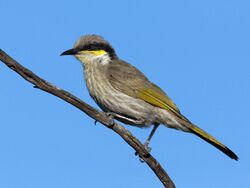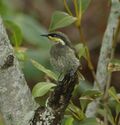Biology:Gavicalis
From HandWiki
Short description: Genus of birds
| Gavicalis | |
|---|---|

| |
| Gavicalis virescens (singing honeyeater) | |
| Scientific classification | |
| Domain: | Eukaryota |
| Kingdom: | Animalia |
| Phylum: | Chordata |
| Class: | Aves |
| Order: | Passeriformes |
| Family: | Meliphagidae |
| Genus: | Gavicalis Schodde & Mason, IJ, 1999 |
| Type species | |
| Melithreptus virescens[1] Vieillot, 1817
| |
Gavicalis is a genus of honeyeaters endemic to New Guinea and Australia. It contains former members of Lichenostomus, and was created after a molecular phylogenetic analysis published in 2011 showed that the original genus was polyphyletic.[2]
The genus contains three species:[3]
| Image | Scientific name | Common Name | Distribution |
|---|---|---|---|
 |
Gavicalis versicolor | Varied honeyeater | New Guinea, northeast Australia |
 |
Gavicalis fasciogularis | Mangrove honeyeater | east Australia |
 |
Gavicalis virescens | Singing honeyeater | Australia |
The name Gavicalis was first proposed by the Australian ornithologists Richard Schodde and Ian Mason in 1999.[4] The word is an anagram of Caligavis introduced by Tom Iredale.[5]
References
- ↑ "Melaphagidae". The Trust for Avian Systematics. https://www.aviansystematics.org/4th-edition-checklist?viewfamilies=119.
- ↑ Nyári, Á.S.; Joseph, L. (2011). "Systematic dismantlement of Lichenostomus improves the basis for understanding relationships within the honeyeaters (Meliphagidae) and historical development of Australo–Papuan bird communities". Emu 111 (3): 202–211. doi:10.1071/mu10047.
- ↑ Gill, Frank; Donsker, David, eds. "Honeyeaters". World Bird List Version 6.1. International Ornithologists' Union. http://www.worldbirdnames.org/bow/honeyeaters/.
- ↑ Schodde, Richard; Mason, Ian J. (1999). The directory of Australian birds : a taxonomic and zoogeographic atlas of the biodiversity of birds in Australia and its territories. Collingwood, VIC Australia: CSIRO. pp. 1–851. ISBN 978-064306456-0.
- ↑ Jobling, James A (2010). The Helm Dictionary of Scientific Bird Names. London: Christopher Helm. p. 171. ISBN 978-1-4081-2501-4. https://archive.org/details/Helm_Dictionary_of_Scientific_Bird_Names_by_James_A._Jobling.
Wikidata ☰ Q14920524 entry
 |

